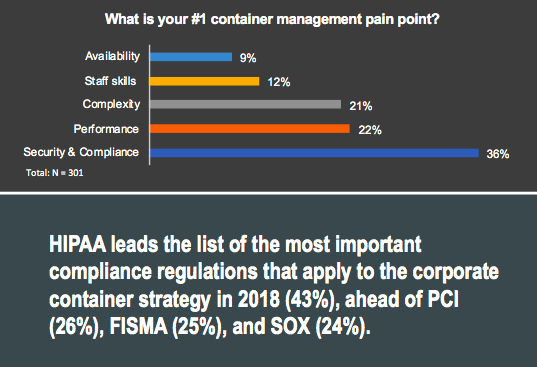The EMA Top 3 report for Container Management and DevOps in Production and at Scale is a curated collection of a large number of data points that reflect individual priorities, pain points, technology adoption patterns, requirements, opinions, and so on, of 300 enterprises. It then dives deeper into these individual data points to provide readers with enough context to inform their technology selection process to some degree. However, each reader needs to pick out the nuggets that are the most relevant to him or her and then draw her own conclusions. Look at it this way: the EMA Top 3 polls 300 of your peers on 58 container and DevOps related questions and you can learn from the answers without having 300 separate conversations.
Example: Why We Selected Chef Habitat and InSpec
The EMA Top 3 selection process is best explained by example. Let me talk through the process, in broad strokes, of why we selected Chef Habitat and InSpec.
Step 1 - We Identify Specific Customer Pain Points and Needs
- Security and compliance is the number one pain point in container management, far ahead even of performance and complexity.
- This importance of security and compliance was a direct result of the prevalence of 'shadow containers' where 72% of enterprises have rogue (ungoverned) containers in their environments. By definition, rogue environments lead to heterogeneous configurations, different handling of data, different scalability policies, etc.
- To make matters harder, 70% use multiple container platforms and we are seeing a head to head race between the four most popular ones: ECS, Azure Container Service, Google Container Engine, and IBM Cloud Container Service. All of these platforms need to be handled differently for compliance, security, performance, availability and so on.
- Finally, in 2018, Functions as a Service (we used to call it serverless computing) is picking up steam so that almost 25% of enterprises want the ability to move their applications there.
 Security and Compliance Is the Number One Container Management Pain Point (Source: EMA Top 3 Report, Q1 2018)
Security and Compliance Is the Number One Container Management Pain Point (Source: EMA Top 3 Report, Q1 2018)
Step 2 - We Define the Exact Customer Requirements
While the real-life selection process included many more data points, these 4 facts illustrate what customers need today: Management solutions that provide application-centric automation and governance across private and public infrastructure of any kind.
Step 3 - We Identify Vendors that Are Optimally Aligned
All of these data points exactly fit with Chef's application automation and compliance framework that aims to make traditional applications and microservices independent of the underlying infrastructure technologies. In other words, Chef Habitat and InSpec dynamically define how an application needs to be deployed and managed, and then they describe these requirements to the Chef Automate engine for continuous enforcement.
Chef Automate will then worry about whether the application is running on bare metal, VMs, containers, PaaS, or FaaS, while developers, platform administrators, compliance engineers, and security officers all have role-based access to create, monitor, and modify these requirements. Especially during faster and faster DevOps release lifecycles, this infrastructure independent approach to managing apps is critical for enterprise customers to be ready when the auditor calls. The entire architectural philosophy of Chef Automate, Habitat, and InSpec aims to solve this key set of container challenges in a declarative and clean manner. Therefore, EMA selected Chef into the Top 3 for Application Deployment and Management for DevOps.
The EMA Top 3 Is Not a Blanket Statement
However, this does not mean that you should simply go out and buy the software. What it does mean is that if most or all of the empirical findings from the report apply to you, you should evaluate Chef Habitat / InSpec. Then it depends on your existing software and hardware infrastructure whether or not this is the right product for you. And this you can only figure out during detailed vendor conversations, demos, and pilot projects.
SaveSave
SaveSave
SaveSave
SaveSave
SaveSaveSaveSave
SaveSave




